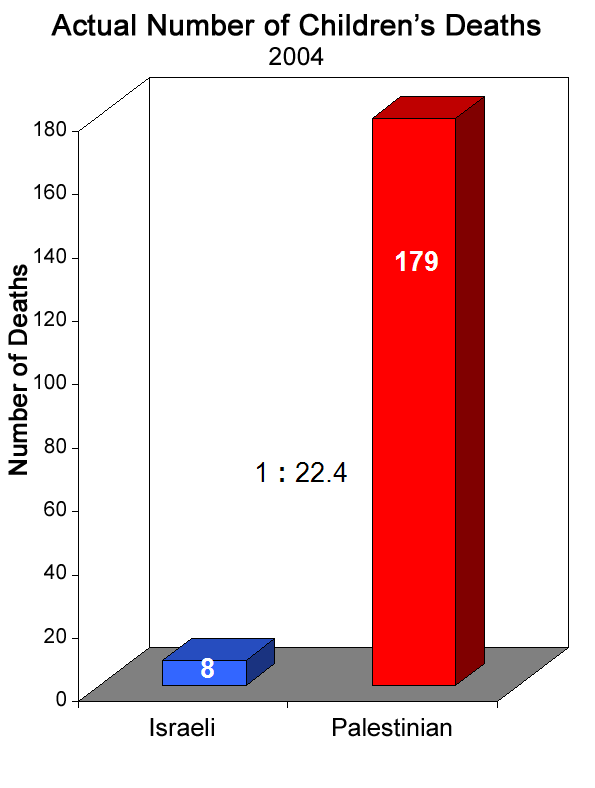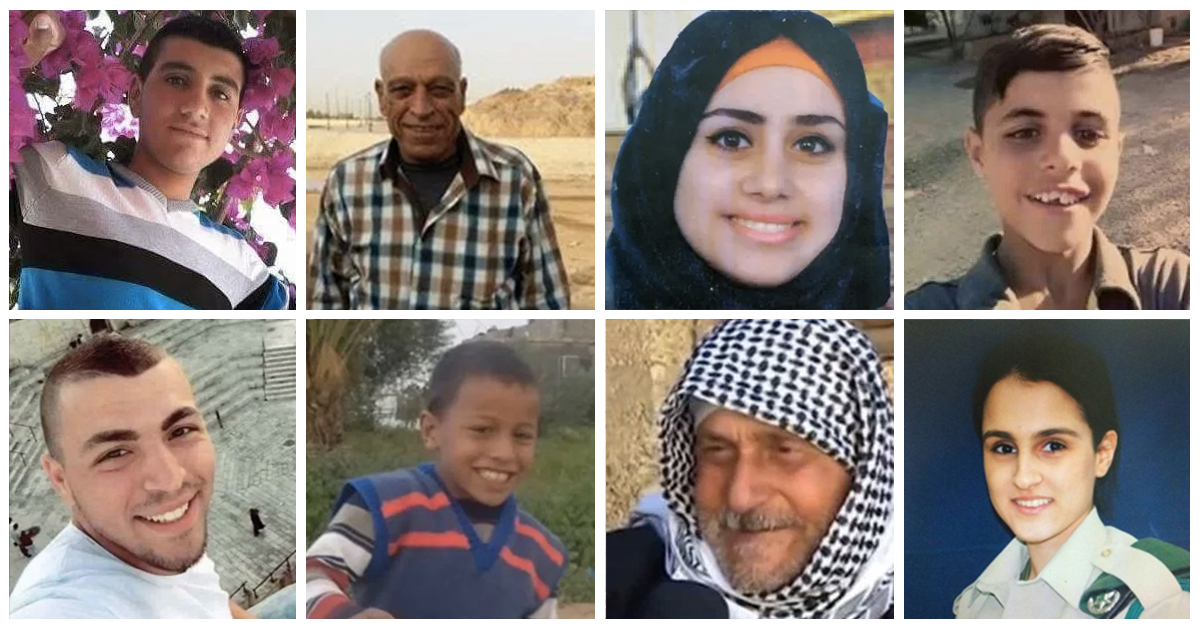| Donate | Contact Us | Materials | Subscribe | Israel-Palestine Timeline | Israel-Palestine News | |
 |
|
An If Americans Knew Report CardDeadly DistortionAssociated Press Coverage of
|
|||||||||||||||||||||||||||||||||||||||||||||||||||||||||||||||||||
Study Period:
January 1, 2004 - December 31, 2004
|
|
In 2003, If Americans Knew1 began issuing report cards to media across the country on their coverage of the Israeli-Palestinian conflict. We provide these reports to media outlets with the aim of assisting them in covering this topic accurately. In addition, we make the reports public, to help readers evaluate for themselves the reliability of their sources of information on this issue.
This study of the Associated Press Newswire (AP) covers 2004, a year for which we have completed studies of The New York Times, and the major network television channels: ABC, NBC, and CBS.
We chose to study AP because it is one of the major sources of world news for Americans. AP, according to its website, is the world’s oldest and largest news organization. Many newspapers depend on it for their international news.
We recognize that reporting on Israel/Palestine is a controversial topic. Therefore, while there are many possible ways to measure accuracy, we chose criteria that are relevant, conducive to statistical analysis, and immune to subjective interpretation.
We chose to focus on the reporting of deaths, because this allows meaningful statistical analysis that would be impossible in a qualitative study. This unambiguous measure allows us to determine whether AP demonstrates even-handed reporting, regardless of nationality or religious background. Fortunately, accurate data for both populations is available from the widely respected Israeli human rights organization, B’Tselem2. We only included Israeli deaths directly caused by the actions of Palestinians, and vice-versa.
This study of AP follows the conventions of our previous studies. Our decision to look at only headlines and first paragraphs was motivated by the goal of assessing the average reader’s experience and the prominence given to the coverage. (In addition, past studies indicate that the patterns found in headline- and lead paragraph-coverage tend to hold when the entire article is examined3.)
We used the LexisNexis database to access all AP articles filed from Israel or the occupied territories (the West Bank and Gaza Strip) during 2004 that went out on the U.S. print wire.
 |
We found a significant correlation between the likelihood of a death receiving coverage and the nationality of the person killed.
In 2004, there were 141 reports in AP headlines or first paragraphs of Israeli deaths. During this time, there had actually been 108 Israelis killed (the discrepancy is due to the fact that a number of Israeli deaths were reported multiple times).
 |
During the same period, 543 Palestinian deaths were reported in headlines or first paragraphs. During this time, 821 Palestinians had actually been killed.4
In other words, 131% of Israeli deaths and 66% of Palestinian deaths were reported in AP headlines or first paragraphs.
That is, AP reported prominently on Israeli deaths at a rate 2.0 times greater than Palestinian deaths.
In reality, 7.6 times more Palestinians were killed than Israelis in 2004.
9 Israeli children’s deaths were reported in the headlines or first paragraphs of AP articles on the Israel/Palestine conflict in 2004, when 8 had actually occurred. During the same period only 27 out of 179 Palestinian children’s deaths were reported. (Children are defined by international law as those who are 17 and younger.) Additionally, Palestinian children made up a disproportionately large number of Palestinian deaths in general. Children’s deaths accounted for 21.8% of the Palestinians killed, while children’s deaths accounted for only 7.4% of Israelis killed during this period. |
 |
 |
22 times more Palestinian children were killed than Israeli children. AP reported on 113% of Israeli children’s deaths in headlines or first paragraphs, while reporting on only 15% of Palestinian children’s deaths. That is, Israeli children’s deaths were reported at a rate 7.5 times greater than Palestinian children’s deaths. |
 |
 |
Comparing running totals for actual deaths and reported deaths once again reveals that while AP’s reporting on Israeli children’s deaths closely tracks the reality, the reporting on Palestinian children’s deaths lags far behind the actual number, following a path similar to Israeli children’s deaths. This is in stark contradiction to the reality, in which Palestinian children were being killed at a rate over 22 times greater than Israeli children.
In order to discover the impact of repetitions on the study, we examined AP’s coverage of children’s deaths without counting repetitions. We found that AP repeated two Israeli children’s deaths once, and one Palestinian child’s death three times. Hence, not counting repetitions, AP covered 88% of Israeli children’s deaths – a rate of coverage 6.5 times greater than their coverage of Palestinian children’s deaths (of which AP covered 13%.)
Many qualitative observations may be made about bias in news coverage. One interesting aspect is the terminology used by a news source in reporting on this conflict. We examined AP’s usage of the words “clash” and “clashes”. Of all the conflict deaths AP reported in 2004, 47 deaths were stated to have taken place during a clash. Every one of those 47 was a Palestinian death, which suggests a more unilateral violence than the word is commonly understood to convey. |
 |
While gathering the data for this study, our analysts looked at hundreds of articles that AP published on topics relating to the Israel/Palestine issue, and noted a number of additional patterns that merit further examination. (The daily reports from the International Middle East Media Center, imemc.org, are useful in evaluating AP's coverage.)
Yet, apart from four stories on a prisoner hunger strike, we could find only two stories that described Israeli prison conditions for Palestinians. Only one AP headline from the area mentioned torture – and this one was about Lebanese, not Palestinian, prisoners.
It is unclear to us why this story would be considered newsworthy for readers in other parts of the world but not for readers in the U.S., Israel’s primary ally. A study comparing AP reports sent to U.S. papers to AP reports sent to international papers might be of interest.
Previous studies have shown newspaper coverage often to be significantly more distorted than the pattern we have found for AP,11 and we wonder if AP’s system for alerting newspapers to the top stories of the day may play a role in this differential. We urge newspapers and AP itself to examine this system. We hypothesize that such an investigation would reveal increased distortion.
We are concerned about the results of this study. As the primary newswire, newspapers across the country rely on AP. Since most newspapers cannot afford to send their own correspondents abroad, AP is often one of only a few sources of international news. We believe the readers of these papers, as well as all Americans, are entitled to full and accurate reporting on all issues, including the topic of Israel/Palestine.
Given that AP had ample coverage of this issue (over 700 news stories on deaths alone), it is troubling that so much critical information for American readers was omitted. Further, our findings suggest a pattern of distortion in AP coverage of the Israeli-Palestinian conflict inconsistent with normal journalistic standards. Such a pattern of distortion, in which readers were given the impression that the Israeli death rate was greater than it was, and that the Palestinian death rate was considerably smaller than its reality, may serve to misinform readers rather than inform them.
In particular, our study shows immense distortion in the coverage of children’s deaths. By covering such a large proportion of Israeli children’s deaths in headlines or first paragraphs and such a low proportion of Palestinian children’s deaths, AP’s coverage obfuscated the fact that in actuality over 22 times more Palestinian children were killed than Israeli children.
Now that AP has been alerted to the distortions in its Israel/Palestine coverage, we encourage it to undertake whatever changes are necessary to provide accurate news coverage of this vital issue.
It would be valuable to examine AP’s structure of reporting from the region, its editorial direction from the international desk in New York, and the specific mechanisms AP has in place, if any, to ensure that bias does not intrude on its reporting on this issue.
Finally, in the interest of full and accurate reporting, we urge AP to inform its readers of the findings of this study. In addition, we encourage AP to report the strategies it intends to use in remedying the significant flaws this study has discovered in its coverage of the Israeli-Palestinian conflict.
2004 |
||
Israeli |
Palestinian |
|
Actual Number of Deaths (All Ages) |
108 |
821 |
Deaths Reported |
141 |
543 |
Percentage of DeathsReported |
130.6% |
66.1% |
Ratio (Israeli % : Palestinian %) |
2.0 : 1 |
|
|
||
Actual Number of Children's Deaths |
8 |
179 |
Children's Deaths Reported |
9 |
27 |
Percentage of Children's Deaths Reported |
112.5% |
15.1% |
Ratio (Israeli % : Palestinian %) |
7.5 : 1 |
|
| Israel-Palestine Timeline |
 |
Israel-Palestine Timeline: The human cost of the conflict records photos and information for each person who has been killed in the ongoing violence. |
| History of the Israel Lobby |

Buy it on Amazon, and visit the book website for reviews, more ordering options, and upcoming author events. |
| IsraelPalestineNews.org |

Information largely missing from U.S. news reports. Read the Blog |
| Media Report Cards |
Off the Charts: ABC, CBS, & NBC |
Off the Charts: New York Times |
| Related Organizations |
| Stay Informed |
|
Sign up for our mailing list and receive an email whenever we post a new article on our news site, Israel-Palestine News. |
This website is printer-friendly. Please Print this article and share it with your friends and family.